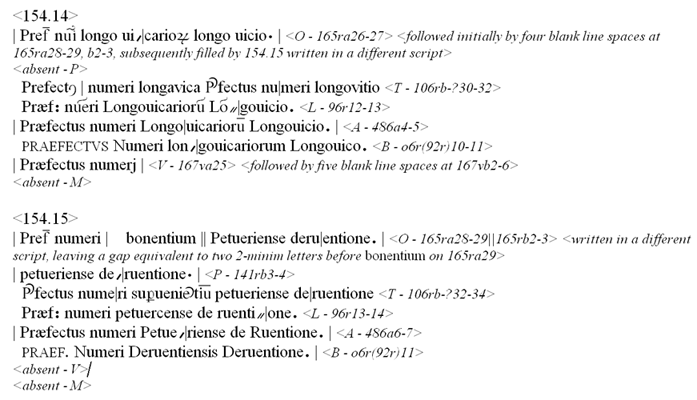
This page created 14 November 2015, and last modified: 14 November 2015

The fourteenth officer listed (154.15 in Ingo Maier's numbering scheme) under the command of the Dux Britanniarum has a troubled manuscript entry (see further details below), but can be said, at least, to refer to a Praefectus numeri Petueriensium.
Entry 154.15 along with the preceding 154.14 are rather confused in the various manuscripts. Ingo Maier reports (personal communication) the primary readings shown below.

Transcription by Ingo Maier, and used with kind permission. O: Bodleian manuscript; P: Parisian manuscript; T: Trento manuscript; L: London (Victoria & Albert) manuscript; A: Alciatus (Basel 1546) printed edition; B: Froben printed edition; V: Vatican manuscript; M: Munich manuscript.It can be seen that in some of the manuscripts, portions of their entries are simply missing, albeit with spaces left for them to be filled in: clearly the entries in whichever manuscript from which they were being copied were hard to read. Seeck (OC.XL.31) took the reading Praefectus supervenientium Petueriens(ium) Deruentione solely from the Trento manuscript, T (V in Seeck's apparatus), but this manuscript is at least one step further removed from the now-lost Speyer codex than is the Bodleian manuscript, O, which gives [..]bonentium, so it is not clear why supervenientium should be a preferable reading, especially since the bonentium was added to O by a second scribe who had thus presumably taken care to check whichever manuscript was being copied at this point.
Assuming supervenientium is a correct reading (which must be considered doubtful), there is a possibility that the unit (but see below) can be equated with the Superventores iuniores (102/5.148) of the Gallic command. However, that unit is much more likely to be related to the men of the Praefectus militum superventorum (151.6) stationed at Mannatias (Civitas Namnetum, modern Nantes) under the Dux tractus Armoricani et Nervicani. This assumes we are dealing with a single unit here; it may well be the Codex Spirensis had two units here, one entry ending in Derventione, and another (154.15.1) ending in Petueriensium.
Derventione is sometimes identfied with Derventio Brigantium (a fort in modern Malton in North Yorkshire), and sometimes with another Derventio (modern Papcastle in Cumbria; yet another fort called Derventio existed in Roman Brain, Little Chester in Derbyshire). Petueriensium would appear to refer to the town of Petuaria (modern Brough-on-Humber); Petuaria does not appear to have hosted a fort, however, so might seem an unlikely garrison location. Inscriptions recovered from Malton have failed to identify the garrison there; the situation at Papcastle is perhaps clearer, with one inscription (RIB 883) dating to 242 referring a C[U]NEUM FRISIONUM ABALLVENSIUM PHILIPP, where the PHILIPP part has been crossed out - i.e. a cuneus of Frisians from Burgh-by-Sands that had been honoured by the future emperor Philippus (reigned 244-249), but whose name was partly obliterated, presumably after his overthrow. This could be the newly-installed garrison, having been replaced in Burgh-by-Sands by the similarly-mounted Numerus Maurorum Aurelianorum Valeriani Gallienique (154.30).
Interestingly, two other cunei of Frisians are known from Britain: a C(uneo) FRIS(iorum) VINOVIE(nsium) (RIB 1036), from Vonovia (modern Binchester), and a CUNEI FRISIORUM VER(covicianorum) SE(ve)R(iani) ALEXANDRIANI (RIB 1594), from Vercovicium (modern Housesteads). The latter of these inscriptions is an altar dedicated by GER(mani) CIVES TUIHANTI from the unit, i.e. by "Germans of the Twente district". Tuihanti were also known as Tubantes: two units in the Notitia carry the name (12.25, 98/9.51).
The meaning of supervenientium is obscure: "supervenire" means either "to overtake", or "to surpass"; it is where the English "supervening" comes from, meaning "to closely follow on from something". But, as mentioned above, supervenientium is in any case not as good a reading as [..]bonentium. Accordingly, not much concrete can be said about the origins, or even the identity, of this unit (or units).
As with all limitanei units in the Notitia, the shield pattern of the numerus Petueriensium [sic] is not illustrated.
1. Ingo Maier; "Appendix 4: Numeration of the new edition of the compilation 'notitia dignitatum' (Cnd)"; last accessed 26 October 2015. See also for here for numbering examples. Return
2. Otto Seeck (Ed.); "Notitia Dignitatum accedunt Notitia urbis Constantinopolitanae et Latercula prouinciarum", Weidmann, Berlin, 1876; available here, at p 210 (last accessed 26 October 2015). Return

Return to the Notitia alphabetical unit list page.
Return to my Notitia index page.